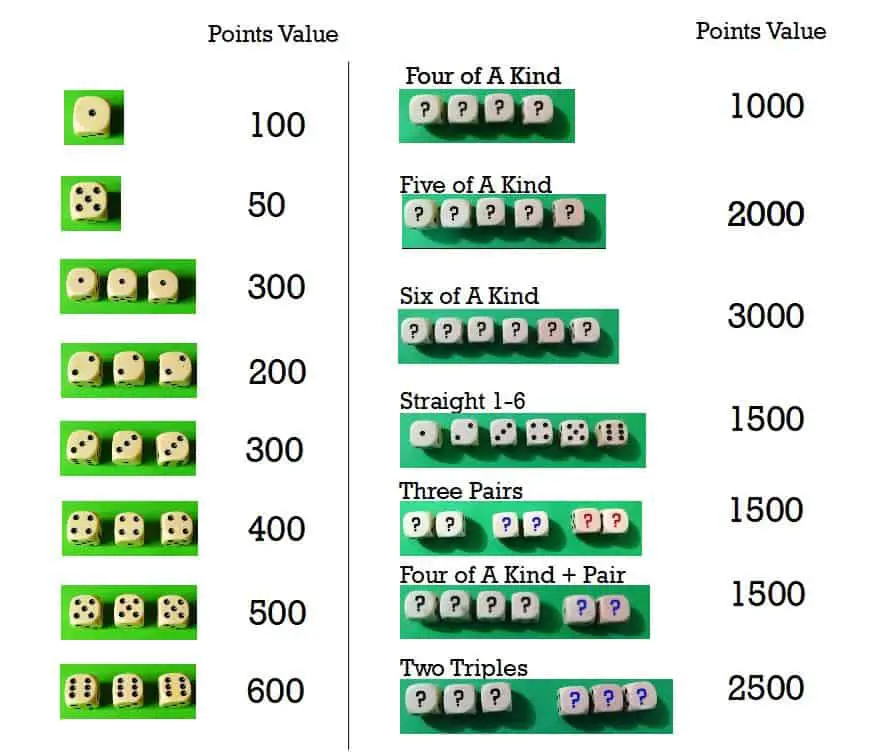

(Farkle has 10 rounds.) For each subsequent dice roll the student should duplicate the slide and update the strategy box. This makes it easy to paste right onto Google Slides.įarkle requires multiple rounds of dice rolling, thus multiple strategies during the same round. What is awesome about Chromebooks is when a screenshot is taken a little pop up comes up giving the student the option to copy to clipboard.
Farkle scores windows#
Chromebook users can use Control + Shift + Windows Switcher Key. Suggestion, that students take a picture or screenshot of their dice roll and place on the Slide. For the scoring die the student will keep, they can drag this onto the gameboard. Notice along the top edge is virtual die to drag. “Did you consider that a 2, 2, 2, 2 and a 2, 2, 2, # are both non Farkle rolls, how does that impact how you would do your calculation?” More important is the students strategy than their actual calculation of this math problem.Ī student rolls dice. This frees up teacher time to offer students challenges like “How would you calculate the probability of a Farkle with 4 die?” and then follow it up with “but what if you had 5 die, how would that change the calculation?” There are actually a lot of things to consider in calculating a Farkle with a lot of die, so the “correct answer” would not necessarily be the goal. Other activities I might have students doing is a Quia game or Desmos activity where the students are practicing probability where the computer gives the student immediate feedback. One thing I advocate is having ONE thing at a time that you’re going back and forth with students on to help develop their critical thinking skills.


When students have different numbers then they must compare and contrast to how they strategized. When students are doing the same problem they check each other’s answers. They have different numbers and different dice rolls. One thing I like about activities such as this Farkle game is each student’s Slides are different. Teachers can also insert comments to help develop students thinking around not only their strategy but ask them to go deeper with their mathematical reasoning for their strategy. Hopefully some comments such as “Interesting that you chose to only roll one die, I would have rolled both of the 5’s” are shared. Have students share their Farkle Slides with a peer. One of the things she promotes is having students value different approaches and strategies. If you follow me you know I massively fangirl Jo Boaler, Stanford math professor, and author of the best book ever Mathematical Mindsets. WHILE students are playing (or even after) the teacher or peers can view the Slides and insert feedback comments to help further the students THINKING and explaining. One of my favorite reasons to use Google Slides is the feedback options. Students can play with physical dice, virtual dice or I have a spreadsheet that simulates rolling Farkle dice. The purpose of my Google Slides for Farkle is to give students a place to explain their STRATEGY and thinking for each round. I also like physical dice, so if you have those use those. First, they need to play and learn the rules. Give them a chance to develop some strategies. Maybe using a mobile game or website is better for students to ENGAGE (From the 5 E’s lesson plan style) with the lesson. Not sure that using my template is the best place to start. Whether or not students calculate the actual probabilities they can understand some of the basic concepts such as rolling 4 die is a better probability of NOT getting a Farkle than 3 die. Farkle is a way for students to demonstrate strategic thinking with mathematical justification. Alexis Gray and I played Farkle where we talked strategy not just point scoring.


 0 kommentar(er)
0 kommentar(er)
